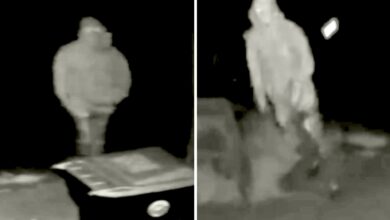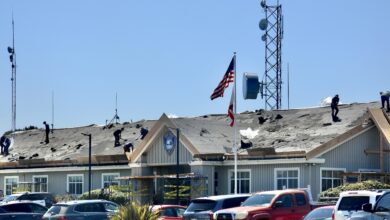Salmon season closes after 90 percent drop
In 2005, local salmon fishing was the best anyone could remember. Almost any boat that left Noyo Harbor could catch a limit of adult Sacramento River salmon by noon. Even this reporter managed to catch fish, which leaped seemingly everywhere in the ocean and hit hard as soon as local fisherman Brad Clark helped me get my line in the water.
Ironically, the same warmer water conditions that made fishing so good for returning adults in 2005 was killing baby salmon just arriving in the ocean that year from that the same river system, said Joe Janisch, president of the Salmon Restoration Association.
The failure of the “class” of 2005 to return to California rivers this year has resulted in the first closure of all ocean salmon fishing in California history. Returning salmon numbers are down 90 percent from 2002. The numbers are so clear that there were no protests of this year”s closure, in contrast to contentious closures in past years.
In fact, when the California Department of Fish and Game banned all ocean salmon fishing on April 15, there was little publicity and no protests.
The state predicts a $255 million economic impact and a loss of 2,263 jobs as a result of the closures.
Chinook salmon runs in the Sacramento River in California”s Central Valley have collapsed. The numbers of salmon returning to spawn, which had held steady at about 475,000 for several years, dropped to 90,000 last year and were expected to be half that this year.
Cause is unknown
Scientists and fishers alike are baffled by the cause. The leading notion put forth so far is a rise in ocean temperatures three years ago, related to both weather cycles and global warming, destroying the food base of the returning class of 2008.
Other suggested causes include water diversions for farming and new housing developments in the Sacramento Valley.
Janisch, a Humboldt State fisheries graduate who spent a lifetime in the field before retiring to Fort Bragg, said the problem could have been foreseen in 2005.
“There were biologists working out in the ocean who were telling us, hey guys, there are no krill here.” But nobody seemed to be paying much attention,” Janisch said.
What was reported widely was the biggest rise in ocean temperatures ever along the Mendocino Coast. That disturbing phenomenon continued in 2006. The higher temperature has been attributed to changes in ocean currents, which in turn are tied to global warming and weather cycles, scientists say.
But the problem isn”t as simple as a warmer ocean.
Water temperatures plunged again last year, bringing back the upwelling of cold waters from the ocean bottom, which feeds the krill.
Janisch explains two- to three-week-old salmon depend on krill for food. The krill depend on nutrients found in cold waters on the bottom that rise to the surface in a process called “upwelling.” Feasting on the tiny shrimp turns the salmon”s flesh pink for life.
But in 2005 and 2006, upwelling was curtailed due to the warmer temperatures.
So why was fishing so good in 2005?
Returning salmon prefer larger prey, especially small schooling fish. In 2005, the salmon followed those hungry, weakened schools and the fishermen caught more salmon than ever.
“But the two- to three-week salmon just arriving in the ocean need krill right away. They don”t have the body fat to keep them alive for a long period of time if there is no food,” Janisch said.
Salmon barbecue
For 37 years, the Salmon Restoration Association has taken money from a tremendously successful “World”s Largest Salmon Barbecue” and used it for mostly unsuccessful efforts to restore salmon populations by hatching baby salmon.
Janisch told the Fort Bragg City Council Monday night that the event will continue but the money will be used for purposes more in line with modern salmon restoration.
“We will be having a barbecue and we will serve (wild caught) salmon. It may be Alaskan salmon at $20 per pound, but we are dedicated to upholding this tradition, despite the circumstances this year,” Janisch told the council.
Over the years, the SRA operated hatcheries on the Georgia Pacific mill site, Big River, Ten Mile River and finally on Hollow Tree Creek, which feeds the Eel River.
The Hollow Tree Hatchery was closed this year due to both scientific questions and federal regulations. In the future, efforts will be directed to fixing streams and rivers along the Mendocino Coast.
“A lot has to do with what has happened to the salmon stocks along the Pacific Coast. Most of the people who work with salmon feel that the best way to spend money is no longer in a hatchery operation but on stream and watershed restoration participation,” Janisch told the City Council.
Janisch said creating healthier rivers and streams is crucial, although it won”t fix problems in the ocean, or global climate change.
Councilman Dave Turner thanked the SRA for continuing an event that he called vital to the entire coastal business community.
Councilwoman Meg Courtney, asked what the price of a ticket will be. The SRA plans to keep the price at or near the $20 of last year.
“The board realizes that if we take a loss, then we take a loss. This year is too important to our community for us to walk away because of the price,” Janisch said.
The SRA board was set to decide the final price of a ticket this week for the July 5 event.
Members of the council, led by Councilman Jere Melo, cook salmon each year as part of a “celebrity cooks” concept that the commercial fishermen who founded the barbecue came up with to broaden the message of the event.
Legislative response
Gov. Arnold Schwarzenegger signed a bill last Friday that will provide $5.3 million in urgent funding to the state Department of Fish and Game for coastal salmon and steelhead fisheries restoration projects.
The bill sponsored by state Sen. Patricia Wiggins of Santa Rosa took effect immediately.
The $5.3 million is part of $45 million included for salmon and steelhead restoration projects. That $45 million is part of a $180 million water quality and supply and coastal protection bond act approved by voters in 2006.
From Caito Fisheries, which has seen two centuries turn in Noyo Harbor, to the whale watching boats catering to the modern tourists, the consensus is this is the worst year ever for those whose living depends upon the Pacific.
World market
On the Pacific Coast of the United States, the state of Washington is the most important salmon producer historically. Scholars agree that dams have caused a steady decline there.
Washington and Northern Oregon will be the only places in the lower 48 where salmon fishing will be allowed, although numbers are down and the catch curtailed. Alaskan rivers are expected to provide the only substantive haul of wild caught salmon.
Canada and even China are expected to contribute farm caught salmon to the market this year in the largest amounts ever. Scientists say raising salmon in pens in areas where wild caught salmon live can spread disease and hurt the natural population and ultimately the genetic base of the entire species.
While Janisch says river and stream fixes are crucial, he sees the current crisis being tied to temporary events in the ocean and sees the possibility that the tough times may pass.
If ocean temperatures are the cause of the disaster, 2009 may not be any better as 2006 was a warm year, although not as warm as 2005.
The SRA will concentrate on stream and river fixes such as logging damage repairs to prevent erosion and derbys to remove invasive pike minnows. The SRA is collaborating with Friends of the Eel River in Arcata and the Noyo River Alliance in Fort Bragg, which is seeking to make improvements in Jackson Demonstration State Forest that will benefit streams.
The Fish and Game Commission postponed action Tuesday on also closing California rivers to salmon fishing. That move is expected in May.




